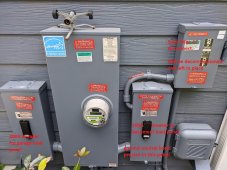Forgive my amazing starting drawing, I banged this out in the few minutes before work so it isn't pretty.
I am early into the planning phase of taking my Solar Edge grid tied system into a eg4 18kpv hybrid inverter. Goal being preserve my net metering, but eventually getting a 15-20KWh battery setup to keep my well pump and essentials going when the grid is down. All essential circuits are already on my basement 200A load panel.
Here is my service entrance/meter and two 200A exterior breakers. The right breaker goes into the basement

From that right 200A breaker, a 4/0 x 3, 2/0 G aluminum service entrance cable enters the basement, runs in the basement ceiling, and powers the basement load panel/breaker box. Again, all essential circuits are in this one panel.
I've got the DC/PV stuff calculated and within spec there. I still need to find/purchase a SolarEdge Key to turn off the optimizer protections and make them compatible with my inverter).

But here is when things get hairy. My plan was the cut the original service entrance cable in my basement (after the 200A exterior breaker), run it into a disconnect (please double check the specs on that disconnect to make sure it is safe), then from the disconnect "downsize" the wire to 3/0 copper x3 and 6 AWG copper ground (the maximum size I can fit in the inverter) into the inverter. Out of the inverter I run the same 3/0 x 3 and 6 AWG ground in conduit back up into the basement ceiling, mount a large junction box that can handle these big-wire unions, and then splice it into the remaining original 4/0 x 3 2/0G service cable to finish the run to the basement load breaker box.
I know just enough to be dangerous, and I'm sure I've overlooked 100 issues. I would love any input, or love someone to tell me just to stop and hire a professional (which I won't do and will just cancel the project).
I am early into the planning phase of taking my Solar Edge grid tied system into a eg4 18kpv hybrid inverter. Goal being preserve my net metering, but eventually getting a 15-20KWh battery setup to keep my well pump and essentials going when the grid is down. All essential circuits are already on my basement 200A load panel.
Here is my service entrance/meter and two 200A exterior breakers. The right breaker goes into the basement

From that right 200A breaker, a 4/0 x 3, 2/0 G aluminum service entrance cable enters the basement, runs in the basement ceiling, and powers the basement load panel/breaker box. Again, all essential circuits are in this one panel.
I've got the DC/PV stuff calculated and within spec there. I still need to find/purchase a SolarEdge Key to turn off the optimizer protections and make them compatible with my inverter).

But here is when things get hairy. My plan was the cut the original service entrance cable in my basement (after the 200A exterior breaker), run it into a disconnect (please double check the specs on that disconnect to make sure it is safe), then from the disconnect "downsize" the wire to 3/0 copper x3 and 6 AWG copper ground (the maximum size I can fit in the inverter) into the inverter. Out of the inverter I run the same 3/0 x 3 and 6 AWG ground in conduit back up into the basement ceiling, mount a large junction box that can handle these big-wire unions, and then splice it into the remaining original 4/0 x 3 2/0G service cable to finish the run to the basement load breaker box.
I know just enough to be dangerous, and I'm sure I've overlooked 100 issues. I would love any input, or love someone to tell me just to stop and hire a professional (which I won't do and will just cancel the project).
Last edited:




